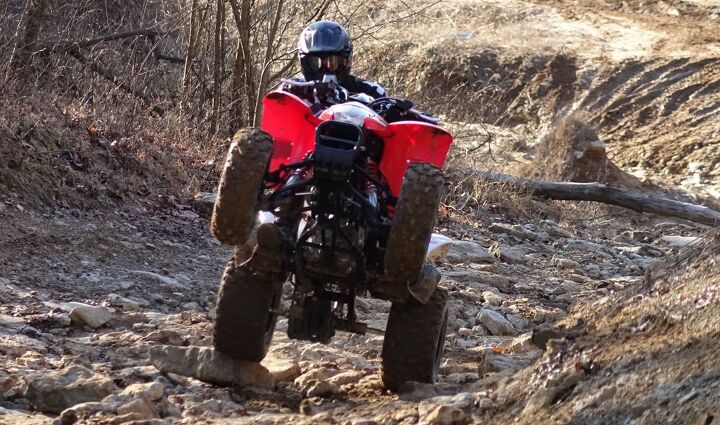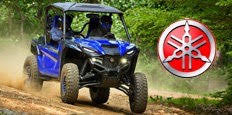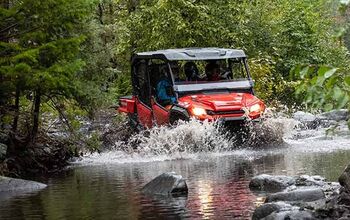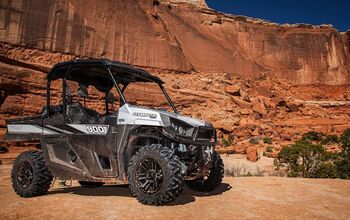2016 Honda TRX250X Review
The 250X has been proving its superb durability since it was released in 2001 as the 250EX. While it hasn’t changed much over the past 15 years, what makes a great entry level machine hasn’t changed much either, and chances are if you’re considering buying a 250X, it’s likely new to you. That’s why the 2016 Honda TRX250X was a machine we were determined to put to the test.
The Honda TRX250X has been in production since 2001.
The 250EX, now 250X, was originally based on Honda’s Recon 250, two-wheel-drive, Utility ATV with a number of changes to reduce its weight and enhance performance and handling. 2006 brought about the addition and extra performance of Honda’s SportClutch, its most significant upgrade to date. The machine’s most recent updates include a switch to new 22×7-10 front and 22×10-9 rear Maxxis tires. For 2016, there are two color options; black and white and a red and white SE model with color-matched red wheel hubs and shock springs, plus an enhanced graphics kit.
To put the TRX250X to the test, we gathered up 16-year- old, 5’7”, 165-pound Ethan Wingate and 43-year old, 5’8”, 205-pound Rob Ray. Wingate outgrew his 90cc automatic CVT- equipped kid’s quad three or four years ago and was thrilled for the opportunity to rediscover riding on a more appropriate-sized machine. Ray’s skill set was utilized to test the limits of the X performance and fun factor. Out test took place partly on the property of Wingate’s grandparents and primarily at Haspin Acres Off-Road Park in Laurel, Ind.
The TRX250X is one of the few remaining ATVs with a five-speed sequential transmission.
Powering the Honda TRX250X is a 229cc, air-cooled, two-valve, pushrod, four-stroke engine fed by a 20mm carburetor. The 250X is the sole holdout in the entry level Sport ATV segment with a sequential five-speed transmission plus reverse. The transmission features an auto clutch, which allows the rider to take off and shift gears without ever touching a clutch lever. Using the SportClutch is completely optional. It acts just like a manual clutch, allowing you to slip the clutch for faster takeoffs or acceleration out of turns.
Shaft drive eliminates chain and sprocket maintenance, but it doesn’t allow you to change the gearing for different size tires and is less efficient at transferring power. To combat power loss, Honda mounted the engine longitudinally, turned 90 degrees in the chassis. This eliminates a 90-degree bend at one end of the drive shaft for more efficient power transfer.
Electric start brings the Honda to life. The handlebar-mounted choke is mandatory for frigid days and the 250X seems to take a good five minutes to warm up and run happily. The engine can only be started in neutral, a pain when the engine is cold and you stall it four or five times. The 250X sounds sporty and in spite of the engine being rubber mounted to reduce vibration, you can still feel the engine’s low RPM thump in the handlebars. No worries; vibration levels taper off some as RPM increase. The exhaust emits a deep, sporty tone that is pleasing to the rider’s ears, yet quiet enough to keep most neighbors happy.
Power delivery is near perfection. It’s most impressive in the first half of the throttle, pulling hard immediately off idle. Low-end snap is amplified somewhat by the auto clutch, which engages a little faster, at a slightly higher RPM than other auto clutches we’ve experienced. Good low-end grunt makes the X feel fun and peppy for its smaller engine size. It allows you to get rolling quickly and easily with or without touching the SportClutch. Good low-end power and a compact chassis make the X a willing wheelie machine.
It doesn’t take much coaxing to get the front wheels up on the TRX250X.
Once warmed up, the auto clutch makes the 250X is virtually stall proof, allowing you to pick your way through tough trail sections with no need to feather the clutch or fear of stalling the engine .
Racing through the midrange part of the power band, the engine seems happy and willing to rev. It’s most fun on tight, twisty trails, and there is enough power and torque on tap to race or crawl your way up most hills as long as you aren’t in heavy power-robbing sand.
On top end, the engine of the Honda TRX250X flattens out with the rev limiter kicking in reminding you it is past time to upshift. Rob noted a small flat spot around ¾ throttle under load. Between that and its cold nature, we suspect jetting is on the lean side to pass emissions. The engine runs quite well for its size and may run even better with a little richer jetting.
When the rev limiter kicks in, you know it’s time to upshift.
We found the gear ratios to be spot on with no annoying gaps. First gear is low enough to crawl along in gnarly sections. Second through fourth were ideal for most trails, with fifth on tap for access roads and meadow trails. As long as the manual SportClutch isn’t pulled in, engine braking is available to help control speed on long downhills or scrubbing off speed for corners. Neutral is located at the bottom of the shift pattern. Pull the lever back on the right side of the body work and shift down from neutral to reverse. It takes a couple practice runs before you remember where to reach for the reverse lever. We found the reverse gearing spot on.
The SportClutch provides light action at the lever. Rob’s experience allowed him to immediately take advantage of the extra performance and control provided by the SportClutch. Thanks to the auto clutch, Ethan quickly picked up the concept of shifting and proper gear selection without being forced to master a manual clutch on his first couple rides.
The Honda TRX250X features a tubular steel chassis with a non-removable subframe. Dual A-arm suspension front and a swing arm with a solid axle out back deliver 5.9” of suspension travel up front and 5.7” rear. Shocks are non-adjustable. Suspension travel is competitive, but on the shorter end for the segment.
The X’s chassis is compact in its class, measuring in at 41.8” wide, with a 44.3”wheelbase, and 31.4” seat height. With its higher clearance shaft drive and a drum rear brake, the 250X enjoys 5.9” of ground clearance.
Honda outfitted the TRX250X with 22” Maxxis tires mounted on lightweight black aluminum wheels, helping keep strength up and rotating weight down. Fully laden with fluids, the Honda is a lightweight in its class at 384 pounds.
On the trail, the ATV’s handling can best be described as light, nimble, and fun. Steering effort is light and accurate, going where you point it with minimal bump feedback felt through the bars. Stability is decent in corners and on moderate sidehills, as long as the terrain isn’t too rough or ridden too aggressively. Body roll isn’t a problem, and the 250X is a willing slider. The engine has enough power to pitch it sideways in turns up to third gear with a 200-pound rider on board, although the machine’s narrower track will get a little tippy if you get too aggressive. With a little experience, you’ll know when you’re pushing the limits before you get there.
The front suspension is fairly stiff and doles out 5.9 inches of travel, which is adequate for this class.
In spite of its compact dimensions, the X feels planted and manageable at higher speeds on fast, relatively smooth trails. Its compact wheelbase adds to the machine’s wheelie prowess without making the front end feel excessively light on steep climbs.
Although the front shocks’ firm settings undoubtedly help keep body roll in check, suspension action is a little firmer than we would like while traversing small bumps and ripples in the trail, regardless of each rider’s size. Smaller tabletops were fun to jump, but Ray’s 205-pound mass was enough to bottom both ends hard when landing from a few feet of air.
The rear end of the TRX250X seems to be a bit plusher than the front.
Overall, the rear end seems a bit plusher and bottoms less. Wingate’s antics never bottomed the suspension hard. However, by the time he starts going as big as Ray, he too will be over-riding the limits of the suspension. We don’t expect a beginner machine to handle big air, but we believe the 250X could benefit from a slightly more forgiving ride over typical imperfections in the trail.
It might be hard to find better all-around tires for the X. The Maxxis tires provided good forward, braking and directional control in every condition we threw at them.
The Honda TRX250X brakes are a mixed bag of good and outstanding. The drum rear brake lacks the feel and instant power of a hydraulic disc brake, but as drum brakes go, it’s about as good as it gets and works pretty well. The front hydraulic disc brakes offer superb feel and awesome stopping power. The 250X stops fast, is easy to control on steep downhills, and stoppies are no problem for the experienced rider.
Smaller to midsize riders will be most comfortable on the TRX250X.
Ergonomically, the 250X fits a large number of riders well. Those between 5’0” and 5’6” will feel right at home. Even taller riders have some room to move around. The relationship between the bars, seat, and footpegs is well laid out for casual or aggressive riding. The seat is flat and easy to move around on, but perhaps a touch too firm for long, casual excursions.
We’re very happy with the feel and operation of the controls, although the parking brake seems dated and takes two or three hands to activate. Neutral and reverse indicator lights make up the machine’s instrument display, which, in our opinion, is perfect. Sport ATVs don’t need unnecessary frills or distractions adding to their retail price.
The Honda TRX250X is rather low maintenance. The air filter can be accessed with no tools and removed with a Philips head screwdriver. Keep it and the oil clean, and the TRX250X should provide years of trouble-free operation. Honda is known for its exceptional quality and durability, and the 250X has proven to live up to the brand’s reputation for more than a decade.
With a base price of $4,699, the TRX450X is an attainable ATV for younger riders.
Unlike most of the other entry-level Sport ATVs in recent history, Honda builds the 250X in house, in its U.S. manufacturing facility in South Carolina, helping ensure quality of craftsmanship and American jobs! The black and white model 250X retails for $4,699, with the red and white SE model we tested listing for $4,899. The base price is at the higher end of the segment, yet it’s affordable enough that a young rider could conceivably save up and purchase one without financing. A family could buy three 250X or two 250X and a 400X or 450R for dad for less than the price of most four-seat UTVs and no one will get stuck in the back seat.
At the end of the day, a great entry level Sport ATV needs to feel quick, handle light and predictably, be extremely durable, and come at a price most enthusiasts can afford. The 2016 Honda TRX250X offers all of that.
The TRX250X is a great first sport quad. It’s a good option for a teen looking to gain experience before moving up to a more powerful and expensive ATV. What’s best is that the 250X is one of those ATVs that’s always nice to have around as nearly anyone can have a great time riding it, and that’s really what Honda’s TRX250X is all about.
| Engine: | 229cc air-cooled OHV longitudinally mounted single-cylinder four-stroke |
| Induction: | 20mm piston-valve carburetor |
| Transmission: | Five-speed with Reverse |
| Clutch: | Honda SportClutch |
| Driveline: | Direct rear drive shaft |
| Front Suspension: | Independent double-wishbone; 5.9 inches travel |
| Rear Suspension: | Swingarm with single shock; 5.7 inches travel |
| Front/Rear Brakes: | Dual hydraulic 174mm discs/Sealed mechanical drum |
| Front Tires: | 22 x 7-10 |
| Rear Tires: | 22 x 10-9 |
| Curb Weight: | 384 lb |
| Length/Width/Height: | 68.5 x 41.8 x 42.6 in |
| Wheelbase: | 44.3 in |
| Ground Clearance: | 5.9 in |
| Fuel Capacity: | 2.5 gallons, including 0.7-gallon reserve |
| MSRP: | $4,699 ($4,899 for SE) |
More by Joe Tolle






































